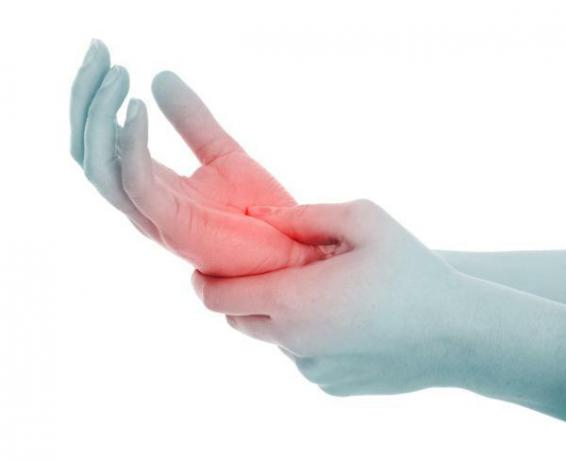
You are talking and suddenly you begin to notice how your pulse quickens, your eyesight and hearing fail. You begin to see distorted and you have the feeling that what is happening to you does not go with you. You decide to close your eyes to calm down and notice how your pulse continues to accelerate. Little by little you have the feeling that your extremities are falling asleep. You open your eyes and see that you are not in a strange position for that to happen and you do not know what to do, you think you are going crazy.
Well, these sensations are among some of the symptoms that can appear in an anguish crisis and one of those that are reported is paresthesia. If you would like to know more about this topic, keep reading! In this article we explain what is paresthesia, its symptoms, its causes and treatment, as well as how long it lasts and where you can notice it.
Index
- What is anxiety paresthesia
- Anxiety paresthesia symptoms
- How long does anxiety paresthesia last?
- In what areas does anxiety paresthesia manifest?
- Causes of Anxiety Paresthesia
- Treatment of paresthesia due to anxiety
What is anxiety paresthesia.
paresthesia is an irritative-type sensitivity disorder that manifests itself with abnormal sensations without the need for prior stimulation, similar to tingling, in this case, associated with symptoms of anxiety and nerves.
It is a feeling with which we are already familiar since at some point we have all had this feeling that some part of the body has fallen asleep, in the vast majority of cases due to a bad position.
But, when it manifests itself recurrently and chronically together with other symptoms such as palpitations, shortness of breath, dizziness, sensation of loss of control, sweating, tremors, derealization, depersonalization, feeling of choking, fear of dying, chills or feeling of heat; will be associated with aanxious symptomatology either panic attack, and then we'll talk about anxiety paresthesia.

Anxiety paresthesia symptoms.
Paresthesia, as we have mentioned, is a symptom that can appear during a panic attack or in certain people within the framework of anxiety disorders. If you ask yourself "How do I know if I have paresthesia due to stress?", the symptoms that may appear as a cause of paresthesia are:
- Trouble breathing.
- Incontinence due to loss of sphincter control.
- Partial or complete loss of sensation.
- Altered level of consciousness.
- Changes in vision.
- Trouble speaking.
How long does anxiety paresthesia last?
Most of the time, paresthesia due to stress is transient and remits with the end of the rest of the anxious symptomatology, when the stimulus that causes it is not presentbe it real or imaginary.
In which areas does paresthesia due to anxiety manifest itself?
Anxiety paresthesia usually manifests in the extremities: arms, hands, feet and legs, although it can also spread to the rest of the body, beginning to notice numbness in the torso or even loss of sensitivity on the head and face (anxiety facial paresthesia). The symptomatology affects both sides of the body either unevenly or evenly.

Causes of anxiety paresthesia.
Anxiety paresthesia can be caused by disorders or diseases that irritate, damage, or compress the nerves, so the central and peripheral nervous system would be affected. In the specific case of paresthesia due to anxiety, the main cause would be anxiety, which may constitute a relevant symptom in the clinical manifestation of some anxiety disorder or even of the crisis of panic.
Treatment of paresthesia due to anxiety.
Treatment for anxiety paresthesia as a symptom associated with a disorder or disease will be the treatment of said disorder or disease, waiting for the remission of the same with the improvement of the main discomfort that has led to the symptomatology of paresthesia.
In this specific case, with the management of panic attacks or anxiety symptoms, the paraesthesia due to stress should remit or decrease. Otherwise, it would be necessary consult a doctor in order to rule out the appearance of other diseases or alterations of the central nervous system that could be causing tremors and numbness of the extremities.
Techniques for treating anxiety paresthesia
Some techniques that can help us manage and reduce paresthesia associated with anxiety are those that focus on control physiological, so that the subject learns to control his own physiological activation and to deal with situations that cause anxiety or stress.
Concentration and exposure to bodily sensations is el main therapeutic component. In this way, we can train the patient in abdominal or diaphragmatic breathing, progressive muscle relaxation and even mindfulness.
If the only cause is anxiety and there is no neurological cause behind the paresthesias, use is not recommended. combination of psychotherapy with psychopharmaceuticals, since these have not shown greater efficacy than psychological therapy isolated.
With the aim of helping you in the treatment of paresthesia due to anxiety, we recommend you consult our posts on Mindfulness exercises for beginners Y relaxation techniques for anxiety.
This article is merely informative, in Psychology-Online we do not have the power to make a diagnosis or recommend a treatment. We invite you to go to a psychologist to treat your particular case.
If you want to read more articles similar to Paresthesia due to anxiety: what is it, symptoms, causes and treatment, we recommend that you enter our category of Clinical psychology.
Bibliography
- American psychiatric association, (2014). Diagnostic and Statistical Manual of Mental Disorders DSM-5. Madrid Spain. Pan American Medical Publishing.
- Ezpeleta, L., & Toro, J. (2014). Developmental psychopathology. Madrid: Pyramid
- Mase, J., (March 23, 2020). Why does an area of my body sometimes fall asleep? Paresthesia. Cinfa Health. Retrieved from: What is paresthesia? Causes and treatment | CinfaHealth
Paresthesia due to anxiety: what is it, symptoms, causes and treatment


